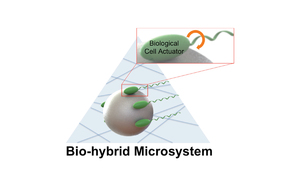Bio-Hybrid Cell-Based Actuators for Microsystems
2014
Article
pi
As we move towards the miniaturization of devices to perform tasks at the nano and microscale, it has become increasingly important to develop new methods for actuation, sensing, and control. Over the past decade, bio-hybrid methods have been investigated as a promising new approach to overcome the challenges of scaling down robotic and other functional devices. These methods integrate biological cells with artificial components and therefore, can take advantage of the intrinsic actuation and sensing functionalities of biological cells. Here, the recent advancements in bio-hybrid actuation are reviewed, and the challenges associated with the design, fabrication, and control of bio-hybrid microsystems are discussed. As a case study, focus is put on the development of bacteria-driven microswimmers, which has been investigated as a targeted drug delivery carrier. Finally, a future outlook for the development of these systems is provided. The continued integration of biological and artificial components is envisioned to enable the performance of tasks at a smaller and smaller scale in the future, leading to the parallel and distributed operation of functional systems at the microscale.
| Author(s): | Carlsen, Rika Wright and Sitti, Metin |
| Journal: | Small |
| Volume: | 10 |
| Number (issue): | 19 |
| Pages: | 3831--3851 |
| Year: | 2014 |
| Month: | June |
| Day: | 4 |
| Department(s): | Physical Intelligence |
| Bibtex Type: | Article (article) |
| DOI: | 10.1002/smll.201400384 |
|
BibTex @article{carlsen2014bio,
title = {Bio-Hybrid Cell-Based Actuators for Microsystems},
author = {Carlsen, Rika Wright and Sitti, Metin},
journal = {Small},
volume = {10},
number = {19},
pages = {3831--3851},
month = jun,
year = {2014},
doi = {10.1002/smll.201400384 },
month_numeric = {6}
}
|
|


